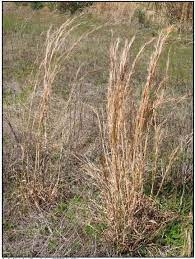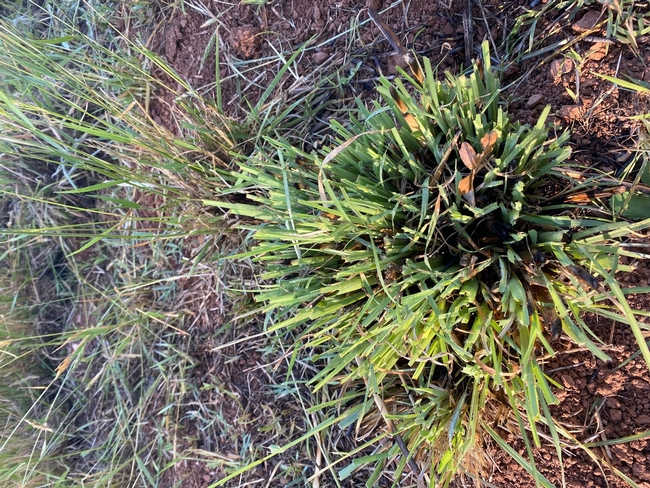
Our older ewes will graze it (some) early in the growing season, but by the time we get back to these pastures in the fall, the plants are too coarse to be palatable. As with most forage plants, palatability and nutrition seem to be related - as the plants become coarse, they also drop in nutritional value. And since the sheep don't graze it late in the year, it seems to be able to out-compete some of the more desirable species (which the sheep will eat).
Over the last decade, we've tried several different approaches. Early on, thinking that fertility was a key factor, we tried fertilizing with triple phosphate. We saw no difference between the areas we fertilized and those we didn't. One of our landlords tried mowing the broomsedge mid-season - which didn't seem to set it back at all, and which also didn't increase its palatability. In 2020 and 2021, I tried spot treating individual plants with glyphosate. These plants were still vegetative (that is, they hadn't flowered or produced seed yet), but in most cases, as the plant died from the herbicide, it seemed to go into hyperdrive and produce seeds. After the 2020 experiment, we didn't notice much difference from our spot spraying - we're still seeing broomsedge in our pastures.
In very early April, I decided to try another type of spot treatment - fire! Using a propane torch, I tried burning individual plants, as well as groups of plants where fire would carry. Broomsedge seems to be more of a warm-season perennial here, so it really hadn't started growing yet.
Obviously, this spring has been atypical, weather-wise (although over the last decade, I'd be hard-pressed to say what "typical" weather is). After I burned the broomsedge, we received more than four inches of rain (more than we measured for January through March 2022). Additionally, we started irrigating in mid-April. Not surprisingly, the burned broomsedge started to grow - sending up new tillers within a week or two of my burning.
Fast-forward to the last two weeks. We finally got the sheep onto the parts of the pasture I'd burned. And they absolutely LOVED the fresh growth on the broomsedge - they selectively grazed the plants that I'd treated (and ignored the decadent plants that I didn't burn). The next step will be to see if these plants stay palatable following our typical rest period (which is usually 35-40 days during this time of year).
By some definitions, a weed is simply a plant that is growing where we don't want it to grow. A weed, in a pasture setting, is a plant that takes up water, nutrients, and sunlight, at the expense of plants that may have greater nutritional value or more palatability. In that sense, broomsedge is definitely a weed - it's growing where I might otherwise be able to grow orchardgrass or clover. But what if I can figure out a cost-effective way to keep it palatable longer into the grazing season? What if I can get the sheep to eat it? Maybe a "weed" is in the eye of the beholder! Stay tuned - I'll provide an update on my observations as we make a second pass through this pasture!
In the meantime, here's a link to some USDA information on broomsedge.
